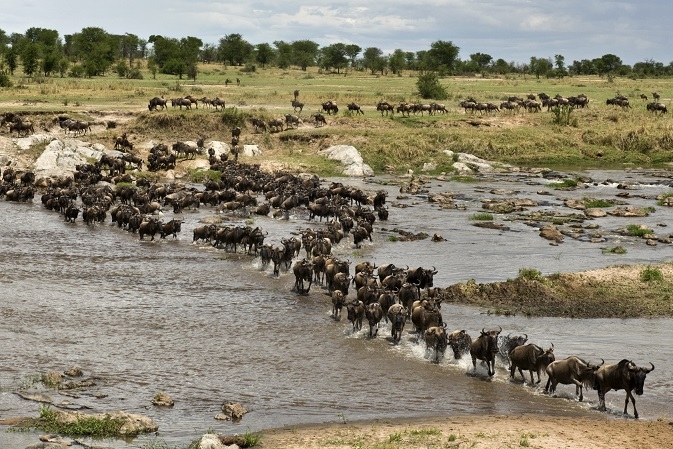
 Nowhere in the world is there a movement of animals as immense as the wildebeest migration, over two million animals migrate from the Serengeti National Park in Tanzania to the greener pastures of the Maasai Mara National Reserve in Kenya. Join veteran safari guide and wildlife expert Jean Du Plessis as he takes viewers on an exhilarating trip across the Serengeti with migrating wildebeest.
Nowhere in the world is there a movement of animals as immense as the wildebeest migration, over two million animals migrate from the Serengeti National Park in Tanzania to the greener pastures of the Maasai Mara National Reserve in Kenya. Join veteran safari guide and wildlife expert Jean Du Plessis as he takes viewers on an exhilarating trip across the Serengeti with migrating wildebeest.
In Animal Planet’s stunning new series NOMADS OF THE SERENGETI, Jean follows the wildebeest on their odyssey across some of Africa’s most incredible locales, including the summit of Mt. Kilimanjaro, Katavi and Ruaha National Park, some of Africa’s most remote parks. With incredible, never-before-seen footage, Jean takes viewers on the expedition of a lifetime as a two-million-strong herd of wildebeest embarks on an 800 km, year-long journey of survival.
Premiering April 4, Monday to Friday at 9 PM on Animal Planet, ‘Nomads of the Serengeti’ documents one of Africa’s truly wondrous natural spectacles.
The Serengeti, one of the oldest intact ecosystems on earth, has evolved over millions of years. It covers an area nearly 14,000 sq. km and spans two countries, Tanzania in the south and Kenya in the north. While for the grazing animals the border between the countries may not present a problem, the rivers that run across the plains and the crocodiles that inhabit those rives most certainly do. Despite the dangers, the voyagers continue on what is the largest mass movement of mammals anywhere in the world.
The Migration
These migrations are prompted by the succession of dry and rainy seasons. Each year the wildebeest (or gnus) and zebra must cross the Serengeti savannah twice.
During the rainy season, the animals graze on the mineral-rich Serengeti plains in the southeastern Tanzania. At the beginning of July, the rainy season ends and the grasslands wither and the wildebeest herds head north.
They cross the Mara River, migrating onto the Massai Plain in southern Kenya where there is still patchy rain nurturing grassy growth. However, the grasses here contain little phosphor, so near the end of the year, at the start of another rainy season, the gnus once more migrate across the Serengeti, returning to Tanzania. On their way, the herds are plagued by many predators, such as lions, hyenas and crocodiles.
 By the way, wildebeest and zebra travel together and graze in perfect harmony because they eat different parts of the grasses.
By the way, wildebeest and zebra travel together and graze in perfect harmony because they eat different parts of the grasses.
The Episodes
Journey to the Short Grass Plains
The Serengeti plains echo to the sound of two million wildebeest. Over the course of the year the giant herd migrates from the North to the South and back again in an endless circle. Wildlife expert and Safari guide Jean Du Plessis is in the North to watch the most treacherous part of the migration–the crossing of the Mara River.
Return to the Mara
Jean Du Plessis is in the south of the Serengeti plains to witness the largest mass birth on the planet. Every year on the short grass plains the Wildebeest migration stops for weeks while the females give birth. Then the entire herd begins to move again, heading back north towards the Mara River where crocodiles lie in wait for what for them is an annual feast.
Ngorongoro
Jean Du Plessis explores the Ngorogoro’s highlands and caldera on the edge of the Serengeti. The caldera is a wildlife haven that some have called a modern day Eden because of the density and diversity of its wildlife. That includes some of the last of Africa’s ‘tuskers’. Jean searches the caldera looking for one of the oldest—- a legendary bull elephant with unbroken tusks who has not been seen for weeks.
Kilimanjaro
The Seregenti’s Mt. Kilimanjaro is the highest freestanding peak in Africa. It has five separate climatic zones, the most of any single place on the planet. Jean Du Plessis has been guiding clients on tours of the Serengeti for twenty years, but now makes his first climb to the peak. His mission is to see whether climate change is affecting the snows on the top of the mountain. And he’s hoping to find evidence that Kilimanjaro may once again be an active volcano.
 Cradle of Mankind
Cradle of Mankind
Jean Du Plessis travels to Mahale Mountains National Park in the hopes of spending time with the wild chimpanzees that live in the forests in this remote and protected corner of Tanzania. Then he’s back to the Serengeti plains to look at the human history of the plains–from the 2 million year old footprints to the Massai.
Jean du Plessis
Jean du Plessis is the founder of both Wayo Africa and Green Footprint Adventures and has been a professional guide all his working life. He spent his childhood running around the African wilderness with Zulu kids in the foothills of the Drakensberg mountains. It was here that a lifestyle in Africa, its people and wildlife was imprinted on him.
Today Jean is working at the forefront of developing new and exciting safari experiences in Tanzania as well as guiding small select groups into the ‘wild and wonderful’. He pioneered both canoeing safaris and night game drives inside Tanzanian National Parks. Jean is the host of an exciting TV series called Ultimate Africa that has been seen on Animal Planet and he is also the director of Wayo Africa, a successful small company passionate about operating authentic safaris in Tanzania.
